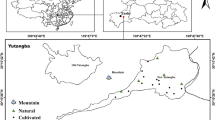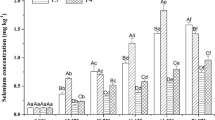Abstract
The present study examined the effect of fertilization with sodium selenite on the selenium content of tea and the nutritional function of Se-enriched tea. Selenium content of tea leaves was increased up to 0.36 μg g−1 by the application of sodium selenite to soil at 0.5 and 1.0 kg Se ha−1. Application by a Se-enriched organic manure at a rate of 0.5 kg Se ha−1 provided a higher biological availability of selenium for plant uptake compared with a similar amount of sodium selenite. Foliar spray of sodium selenite at 50–100 g Se ha−1 increased the selenium content to 0.32–1.45 μg g−1 in tea leaves sampled at the 8–26 days after spraying. Selenium content in the blood and liver, glutathione peroxidase activity in blood of rats were significantly enhanced by feeding of an extracted solution of Se-enriched tea leaves and sodium selenite. Glutathione peroxidase activity in liver of rats fed with Se-enriched tea was higher than that fed with sodium selenite, indicating that the selenium in Se-enriched tea leaves is a more effective Se source than sodium selenite. Increasing the Se level in food products through the application of a selenium fertilizer is a safe, effective and feasible means of increasing the selenium intake of human and animals in low selenium areas of China.
Similar content being viewed by others
References
Aro A, Alfthun G and Varo P 1995 Effect of supplementation of fertilizer on human selenium status in Finland. Analyst 120, 841–843.
Aoseer Buber, Zhang Dongwei and Liu Li 1995 Regional environmental differentiation and regional safety threshold of soil selenium. Acta. Pedologica Sinica 32(20), 189–193 (in Chinese with English abstract).
Chen L C and Hu Q H 2000 Determination of selenium levels in major foodstuff for evaluation of selenium nutrition status of residents in Nanjing. Food Sci. 21, 56–58 (in Chinese with English abstract).
Combs J G F 1997 Selenium as a cancer-protective agent. Bulletin of Selenium-Tellurium Development Association, Grimbergen, Belgium Feb., 1-4.
Conor Reilly 1998 Selenium: A new entrant into the functional food arena. Trends Food Sci. Technol. 9, 114–118.
Diaz-Alarcon J P, Navarro-Alarcon M and Serrana L G D 1994 Determination of selenium levels in vegetables and fruits by hydride generation atomic absorption spectropyotometry. J. Agric. Food Chem. 42, 2848–2851.
Du Qizhen, Shen Xingrong and Fang Xinghan 1991 Selenium components analysis of tea leaves. Tea Sci. 11 (2), 133–137 (in Chinese with English abstract).
FDA 1987 Food additives permitted in feed and drinking water of animal. Selenium. Fed. Regist. 52, 10887.
Foster L H and Sumar S 1997 Selenium in health and disease, A review. Crit. Rev. Food Sci. Nutr. 37, 211–228.
Ge K and Yang G 1993 The epidemiology of selenium deficiency in the etiology of endemic diseases in China. Am. J. Clin. Nutr. Supp. 57, 259–263.
Gupta U C and Gupta S C 2000 Selenium in soils and crops, its deficiencies in livestock and humans, implications for management. Commun. Soil Sci. Plant Anal. 31, 1791–1807.
Johanna K L and Kishorchanra G 1987 Selenium deficiency, endurance exercise capacity and antioxidant status in rats. J. Appl. Physiol. 63, 2532–2536.
Levander O A 1987 A global view of human selenium nutrition. Ann. Rev. Nutr. 1, 227–250.
Mahan D C and Kim Y Y 1996 Effect of inorganic or organic selenium at two dietary levels on reproductive performance and tissue selenium concentrations in first-parity gilts and their progeny. J. Anim. Sci. 74, 2711–2718.
Mejuto-Marti M, Bollain-Rodriguez M, Herrero-Latorre C and Bermejo-Martinez F 1988 Selenium content of vegetables, fruits and cereals in Galicia (Northwest Spain). J. Agric. Food Chem. 36, 293–295.
Qiuhui Hu and Genxing Pan 1999 Techniques and effect for production of Se-enriched tea in low selenium soil of tea garden. J. Nanjing Agricultural University 22(3), 91–94 (in Chinese with English abstract).
Qiuhui Hu, Ruixing Ding and Genxing Pan 1999 Study on dissolved rate of selenium and chemical form and property of Se in Seenriched tea. Scientia Agricultura Sinica 32, 69–72 (in Chinese with English abstract).
Qiuhui Hu 2000 Effects of Se-enriched tea leaves on immunity function. Food Sci. 21 (11), 56–58 (in Chinese with English abstract).
Qiuhui Hu, Genxing Pan, Xinxin An and Ruxing Ding 2001 Physiological function of Se-enriched tea fertilized with sodium selenite and naturally high-Se tea in rats. J. Sci. Food Agric. 81, 202–204.
Qu Jinwen and Wu Yingliang 1994 Analysis of value state and chemical forms of selenium in biological samples of enriched selenium. Research and Exploitation of Natural Products 2, 98–100 (in Chinese with English abstract).
Shi B and Spallholz J E 1994 Selenium from beef is highly bioavilable as assassed by liver glutathione peroxidase activity and tissue selenium. Br. J. Nutr. 72, 873–881.
Turner R J and Francis J E 1991 Selenium and the immune response. Proc. Nutr. Soc. 50, 275–285.
Ullrey D E 1987 Biochemical and physiological indicator of selenium status in animals. J. Anim. Sci. 65, 1712–1726.
Valle G, McDowell R and Wilkinson N S 1993 Selenium concentration of bermudagrass after spraying with sodium selenate. Commun. Soil Sci. Plant Anal. 24, 1763–1768.
Zheng Jianxian and Li Xuan 1997 Natural organic selenium and selenium enriched grain food. Food Industry 3, 25–27 (in Chinese with English abstract).
Author information
Authors and Affiliations
Corresponding author
Rights and permissions
About this article
Cite this article
Hu, Q., Pan, G. & Zhu, J. Effect of fertilization on selenium content of tea and the nutritional function of Se-enriched tea in rats. Plant and Soil 238, 91–95 (2002). https://doi.org/10.1023/A:1014266613165
Issue Date:
DOI: https://doi.org/10.1023/A:1014266613165




